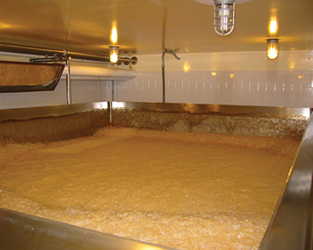
Open fermenters have been used for more than 98% of the history of beer brewing and I would be silly to proclaim their use either not practical or antiquated. There are many beers available that are fermented in open vessels. To my knowledge, Anchor Brewing continues to use open fermentation for their beers. I have no knowledge of Coopers’ fermentation methods and can’t offer specific information about their process.
I can tell you that I worked at a brewery in Davis, California while in graduate school and we produced excellent German-style lager and weizen beers in open fermenters. The worse thing that ever happened to an open fermentation when I was working at this brewery was when some stupid, and likely drunk, college kid snuck into our cellar and used one of the fermenting lager fermenters as a “hot” tub . . . it was a maintained at a muscle soothing temperature of 10 °C (50 °F)! Luckily, this moron left with his health intact; fermenting beer produces carbon dioxide and open fermenters have a blanket hovering above the top of the vessel, right at nose level when one is bobbing around in one.
Open fermentation actually has several brewing merits. The shallow depth of the vessel makes for a fruitier beer since hydrostatic pressure, encountered in taller tanks, reduces ester formation during fermentation. At home, you are not going to notice this since when I mention “tall tanks” I am speaking of vessels that are at least 20 feet (6 m) tall. Open fermenters can also be skimmed of that brown yeast-trub stuff that rises to the top of fermenting beer. Many brewers remove this layer, often called braun hefe, in order to improve finished beer flavor. So skimming is good. Yeast can also be cropped from open fermenters and many brewers proclaim that yeast cropped from open fermentation tanks is superior to yeast harvested from conical fermenters.
But brewers who use open fermenters realize that there are real sanitation concerns with these vessels and keep them in special rooms that are designed to guard against contamination from the environment. Marketing types like to show images that make their consumers think, “Wow!” Open fermenters are one such image, but it is important to consider that these vessels are not simply parked out behind the brewhouse. There is nothing romantic or remarkable about contaminated beer and brewers who use open vessels for fermentation are not as carefree as marketing photographs depict.
Unless you are a very seasoned brewer with everything, I mean everything, under control I do not recommend the use of open fermentation at home or in a commercial brewery. To me the goal of homebrewing is the production of a pleasant and rewarding beer and the use of open fermentation vessels can easily end in frustration unless very special considerations about sanitation and prevention of contamination are made. Other than those concerns, I am totally in favor of this method of fermentation.
 Open fermenters have been used for more than 98% of the history of beer brewing and I would be silly to proclaim their use either not practical or antiquated. There are many beers available that are fermented in open vessels. To my knowledge, Anchor Brewing continues to use open fermentation for their beers. I have no knowledge of Coopers’ fermentation methods and can’t offer specific information about their process.
I can tell you that I worked at a brewery in Davis, California while in graduate school and we produced excellent German-style lager and weizen beers in open fermenters. The worse thing that ever happened to an open fermentation when I was working at this brewery was when some stupid, and likely drunk, college kid snuck into our cellar and used one of the fermenting lager fermenters as a “hot” tub . . . it was a maintained at a muscle soothing temperature of 10 °C (50 °F)! Luckily, this moron left with his health intact; fermenting beer produces carbon dioxide and open fermenters have a blanket hovering above the top of the vessel, right at nose level when one is bobbing around in one.
Open fermentation actually has several brewing merits. The shallow depth of the vessel makes for a fruitier beer since hydrostatic pressure, encountered in taller tanks, reduces ester formation during fermentation. At home, you are not going to notice this since when I mention “tall tanks” I am speaking of vessels that are at least 20 feet (6 m) tall. Open fermenters can also be skimmed of that brown yeast-trub stuff that rises to the top of fermenting beer. Many brewers remove this layer, often called braun hefe, in order to improve finished beer flavor. So skimming is good. Yeast can also be cropped from open fermenters and many brewers proclaim that yeast cropped from open fermentation tanks is superior to yeast harvested from conical fermenters.
But brewers who use open fermenters realize that there are real sanitation concerns with these vessels and keep them in special rooms that are designed to guard against contamination from the environment. Marketing types like to show images that make their consumers think, “Wow!” Open fermenters are one such image, but it is important to consider that these vessels are not simply parked out behind the brewhouse. There is nothing romantic or remarkable about contaminated beer and brewers who use open vessels for fermentation are not as carefree as marketing photographs depict.
Unless you are a very seasoned brewer with everything, I mean everything, under control I do not recommend the use of open fermentation at home or in a commercial brewery. To me the goal of homebrewing is the production of a pleasant and rewarding beer and the use of open fermentation vessels can easily end in frustration unless very special considerations about sanitation and prevention of contamination are made. Other than those concerns, I am totally in favor of this method of fermentation.
Open fermenters have been used for more than 98% of the history of beer brewing and I would be silly to proclaim their use either not practical or antiquated. There are many beers available that are fermented in open vessels. To my knowledge, Anchor Brewing continues to use open fermentation for their beers. I have no knowledge of Coopers’ fermentation methods and can’t offer specific information about their process.
I can tell you that I worked at a brewery in Davis, California while in graduate school and we produced excellent German-style lager and weizen beers in open fermenters. The worse thing that ever happened to an open fermentation when I was working at this brewery was when some stupid, and likely drunk, college kid snuck into our cellar and used one of the fermenting lager fermenters as a “hot” tub . . . it was a maintained at a muscle soothing temperature of 10 °C (50 °F)! Luckily, this moron left with his health intact; fermenting beer produces carbon dioxide and open fermenters have a blanket hovering above the top of the vessel, right at nose level when one is bobbing around in one.
Open fermentation actually has several brewing merits. The shallow depth of the vessel makes for a fruitier beer since hydrostatic pressure, encountered in taller tanks, reduces ester formation during fermentation. At home, you are not going to notice this since when I mention “tall tanks” I am speaking of vessels that are at least 20 feet (6 m) tall. Open fermenters can also be skimmed of that brown yeast-trub stuff that rises to the top of fermenting beer. Many brewers remove this layer, often called braun hefe, in order to improve finished beer flavor. So skimming is good. Yeast can also be cropped from open fermenters and many brewers proclaim that yeast cropped from open fermentation tanks is superior to yeast harvested from conical fermenters.
But brewers who use open fermenters realize that there are real sanitation concerns with these vessels and keep them in special rooms that are designed to guard against contamination from the environment. Marketing types like to show images that make their consumers think, “Wow!” Open fermenters are one such image, but it is important to consider that these vessels are not simply parked out behind the brewhouse. There is nothing romantic or remarkable about contaminated beer and brewers who use open vessels for fermentation are not as carefree as marketing photographs depict.
Unless you are a very seasoned brewer with everything, I mean everything, under control I do not recommend the use of open fermentation at home or in a commercial brewery. To me the goal of homebrewing is the production of a pleasant and rewarding beer and the use of open fermentation vessels can easily end in frustration unless very special considerations about sanitation and prevention of contamination are made. Other than those concerns, I am totally in favor of this method of fermentation.

